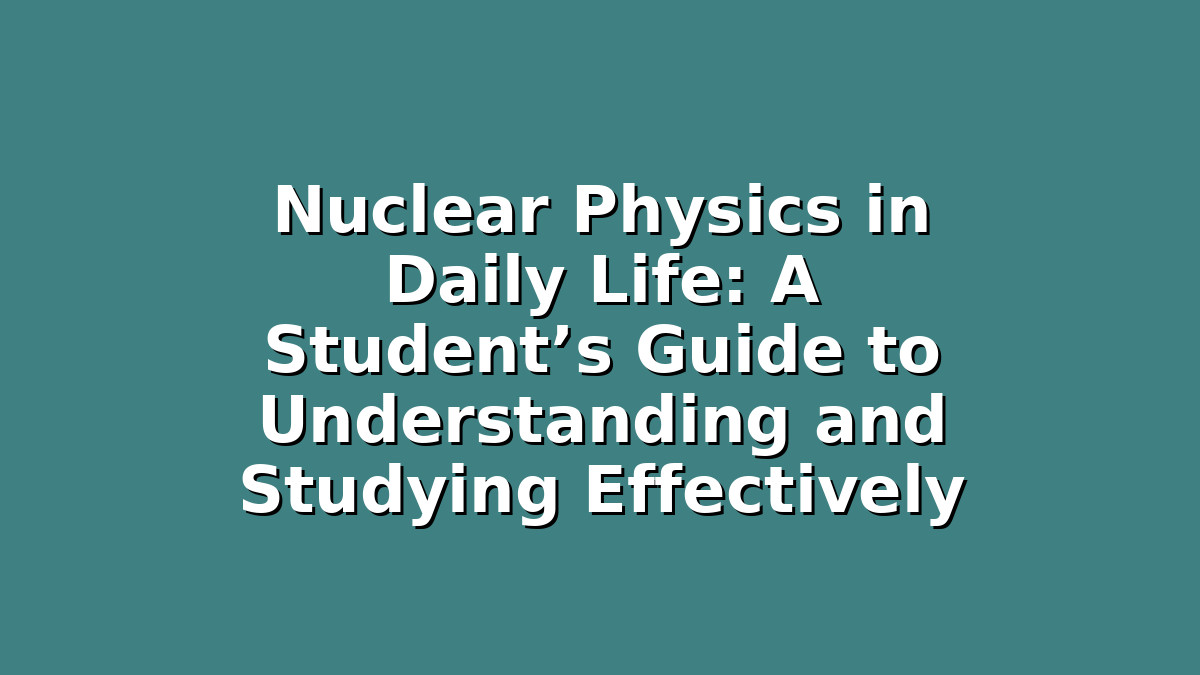Nuclear physics might sound like a complex and distant field, confined to high-tech laboratories and scientific research centers. However, its principles and applications are surprisingly relevant in our everyday lives. For students preparing for exams or seeking effective study strategies, understanding how nuclear physics connects to daily phenomena can make the subject more relatable and easier to grasp. This article will explore the role of nuclear physics in daily life, provide study tips tailored to mastering its concepts, and offer advice on how to approach this fascinating yet challenging topic with confidence.
Introduction: Why Nuclear Physics Matters to You
When you hear “nuclear physics,” you might think about atomic bombs or nuclear reactors—topics that seem far removed from a student’s daily routine. But nuclear physics isn’t just about explosive power or energy production. It’s a fundamental branch of science that explains how atoms behave, how energy is released, and how radiation interacts with matter. From medical imaging and cancer treatment to energy generation and even your smartphone, nuclear physics principles underpin many technologies and processes around you.
For students, understanding nuclear physics can not only help you ace your exams but also inspire a deeper appreciation for science and its impact on the world. However, given its complexity, it’s normal to feel overwhelmed. The good news is, with the right approach and study techniques, you can master nuclear physics concepts and see their relevance clearly.
Section 1: Nuclear Physics in Everyday Technologies and How to Study Them
One of the best ways to learn nuclear physics is by connecting theory to practical examples you encounter daily. Here are some key areas where nuclear physics plays a crucial role:
– Medical Applications: Techniques like X-rays, PET scans, and radiation therapy all rely on nuclear physics. X-rays use ionizing radiation to create images of bones and tissues, while PET scans detect radioactive tracers to observe metabolic processes. Radiation therapy uses targeted radioactive isotopes to kill cancer cells.
– Energy Production: Nuclear reactors generate electricity by splitting atoms in a process called nuclear fission. Understanding how a chain reaction works and how energy is released in this process is fundamental in nuclear physics.
– Smoke Detectors: Many smoke detectors contain a small amount of radioactive material, Americium-241, which ionizes air to detect smoke particles quickly.
– Carbon Dating: Archaeologists use carbon-14 dating, based on radioactive decay principles, to determine the age of ancient artifacts and fossils.
Study Tip: When you encounter these real-life applications in your textbook or lectures, pause and make a list of examples. Try to explain how nuclear physics is involved in your own words. This active recalling helps reinforce concepts and creates mental links between abstract ideas and practical uses.
Section 2: Breaking Down Complex Concepts with Visual Aids and Analogies
Nuclear physics involves abstract ideas such as nuclear forces, radioactive decay, and particle interactions that can seem intimidating. To study effectively, use visual aids and analogies to simplify these concepts:
– Nuclear Structure: Imagine the nucleus as a tightly packed group of protons and neutrons held together by nuclear forces, similar to a strong magnet holding metal beads. Visual diagrams showing the nucleus with labeled components can clarify this structure.
– Radioactive Decay: Think of radioactive atoms like unstable spinning tops that eventually fall over. Different types of decay (alpha, beta, gamma) are like different ways the top might fall or lose energy.
– Nuclear Reactions: Picture nuclear fission as a billiard ball breaking into multiple smaller balls, releasing energy as it splits. Fusion, conversely, is like two smaller balls merging into one larger ball, releasing even more energy.
Study Tip: Create your own sketches or find animations online to visualize these processes. Drawing the steps of a nuclear reaction or decay chain can help you internalize the sequence and significance of each stage. Additionally, teaching these concepts to a study partner or even to yourself aloud can deepen your understanding.
Section 3: Effective Exam Preparation Strategies for Nuclear Physics
Mastering nuclear physics for exams requires focus, practice, and strategic revision. Here are some tailored tips to help you prepare effectively:
– Understand the Formulas, Don’t Just Memorize: Nuclear physics involves important formulas related to decay rates, half-life, binding energy, and more. Instead of rote memorization, focus on understanding the derivation and physical meaning behind these formulas. This approach helps you apply knowledge to different problems.
– Practice Problem-Solving Regularly: Work through past exam questions and textbook problems involving calculations and conceptual questions. Nuclear physics problems often test your ability to apply theory to practical situations, such as calculating the remaining activity of a radioactive sample after a certain time.
– Use Flashcards for Key Terms and Definitions: Flashcards are effective for memorizing terms like isotopes, half-life, nuclear fission, and fusion. Include a brief explanation or example on the back to reinforce meaning.
– Form Study Groups: Collaborating with peers allows you to discuss difficult concepts, quiz each other, and share different study methods. Sometimes, a friend’s explanation can make a tricky topic clearer.
– Incorporate Regular Breaks and Stay Positive: Nuclear physics can be challenging, so it’s important to avoid burnout. Use techniques like the Pomodoro method (25-minute focused sessions followed by breaks) and maintain a positive mindset. Remind yourself that persistence and consistent effort lead to mastery.
Conclusion: Embracing Nuclear Physics as Part of Your Learning Journey
Nuclear physics might seem daunting at first glance, but recognizing its role in everyday technologies and employing effective study strategies can transform your understanding and performance. By relating nuclear physics concepts to real-world examples, using visual aids and analogies, and adopting focused exam preparation techniques, you can build confidence and excel in this subject.
Remember, every expert was once a beginner, and your dedication to learning today sets the foundation for your success tomorrow. Keep curious, stay motivated, and let the fascinating world of nuclear physics inspire you not just for exams, but for a lifelong appreciation of science.

Responses